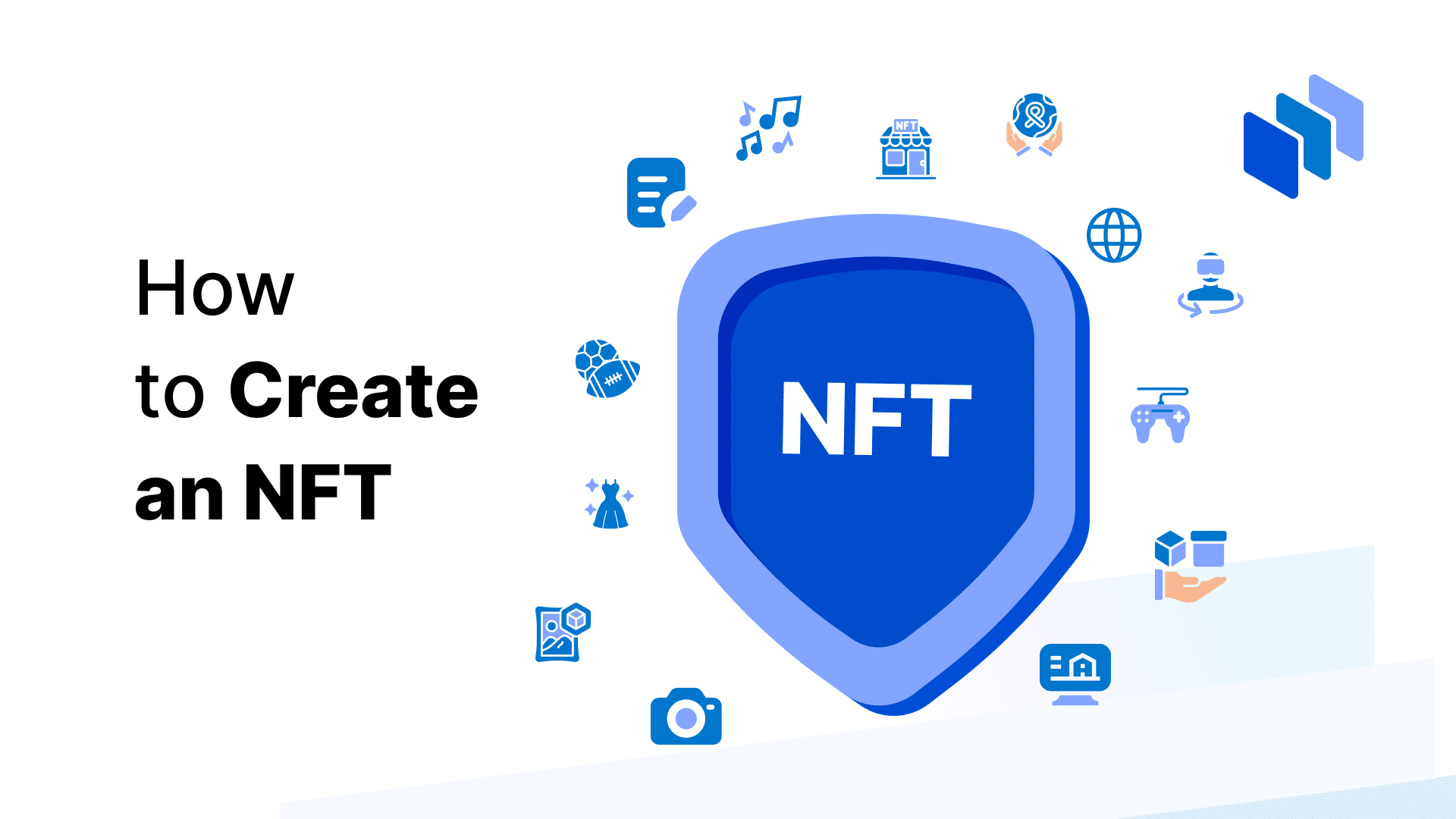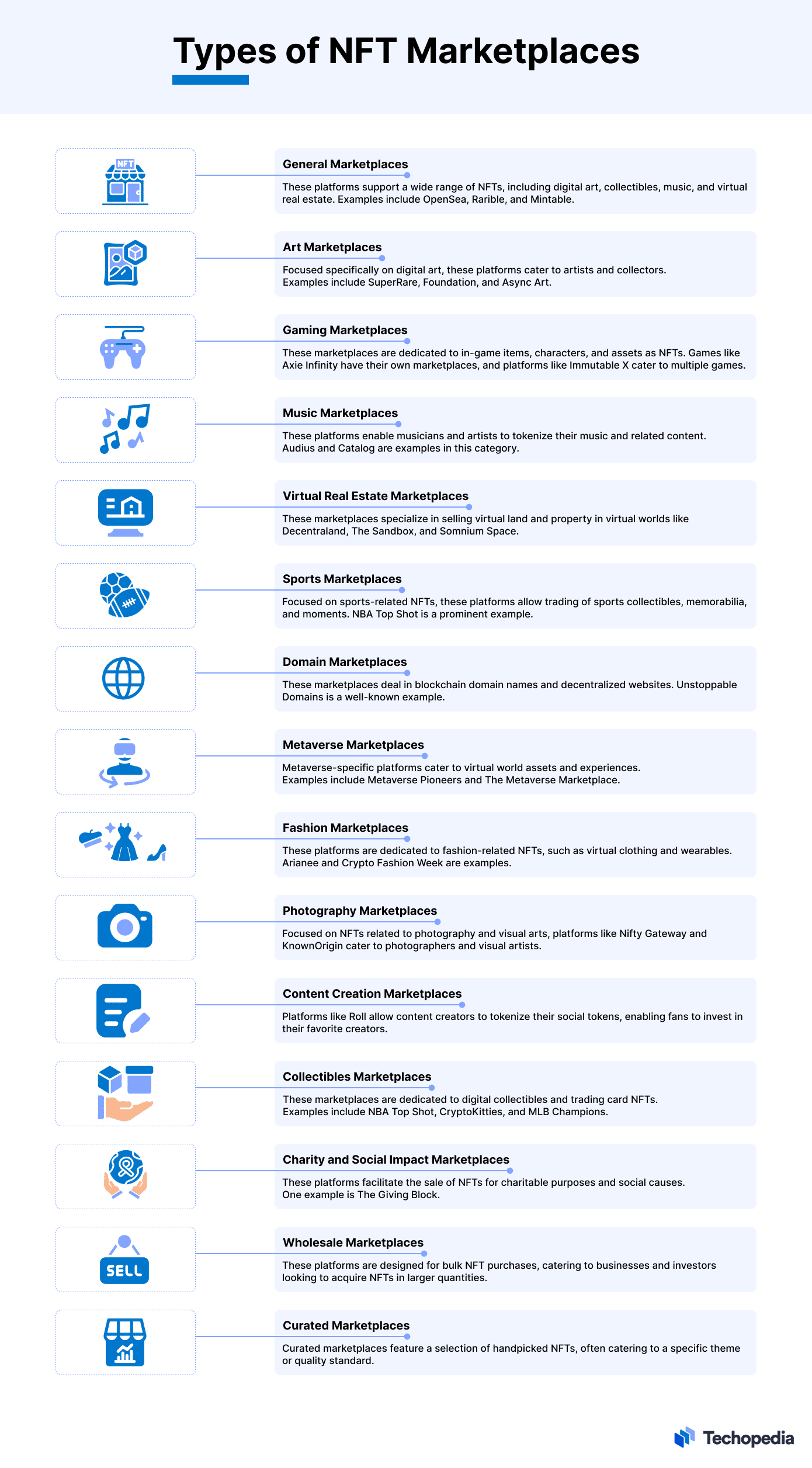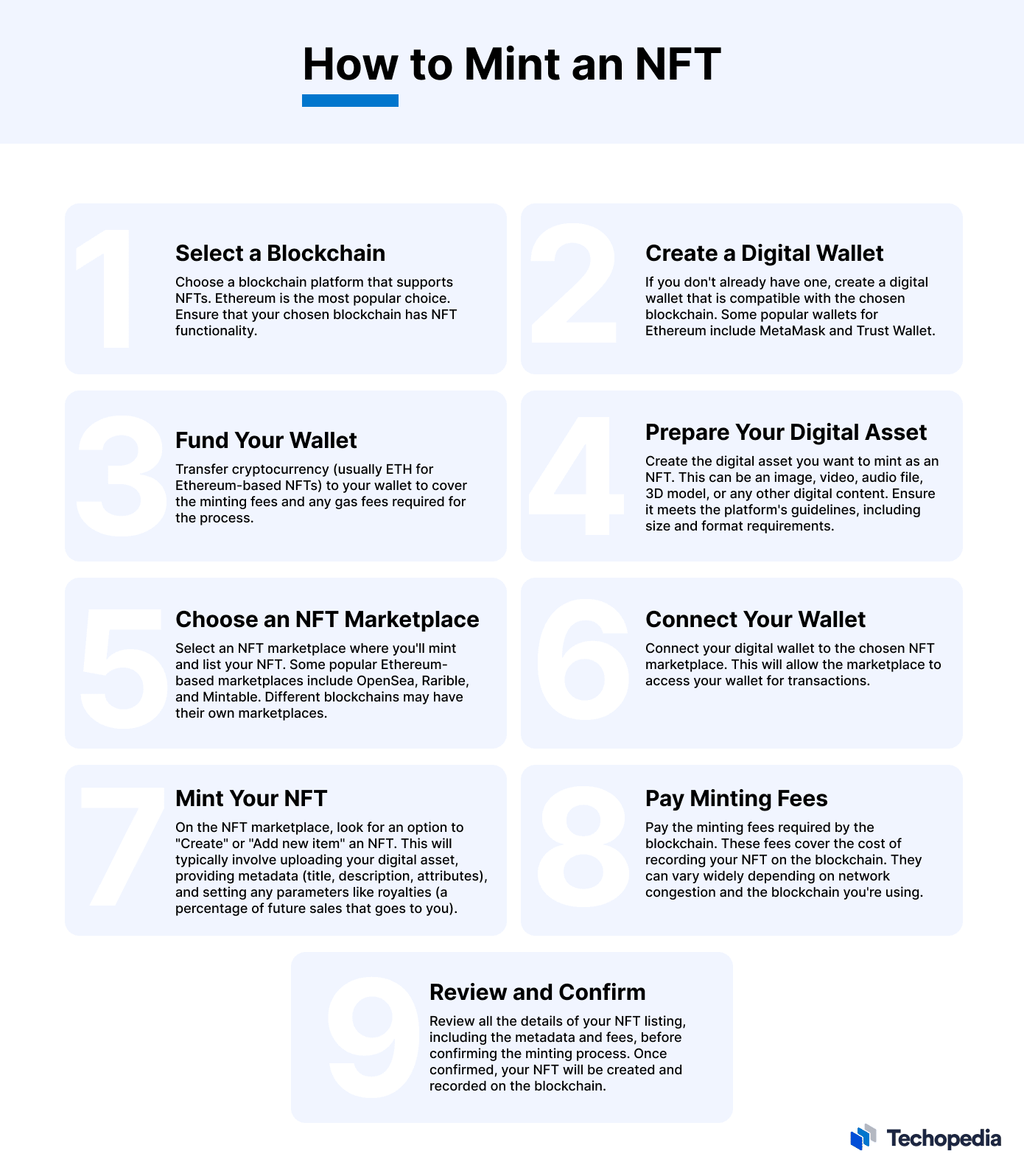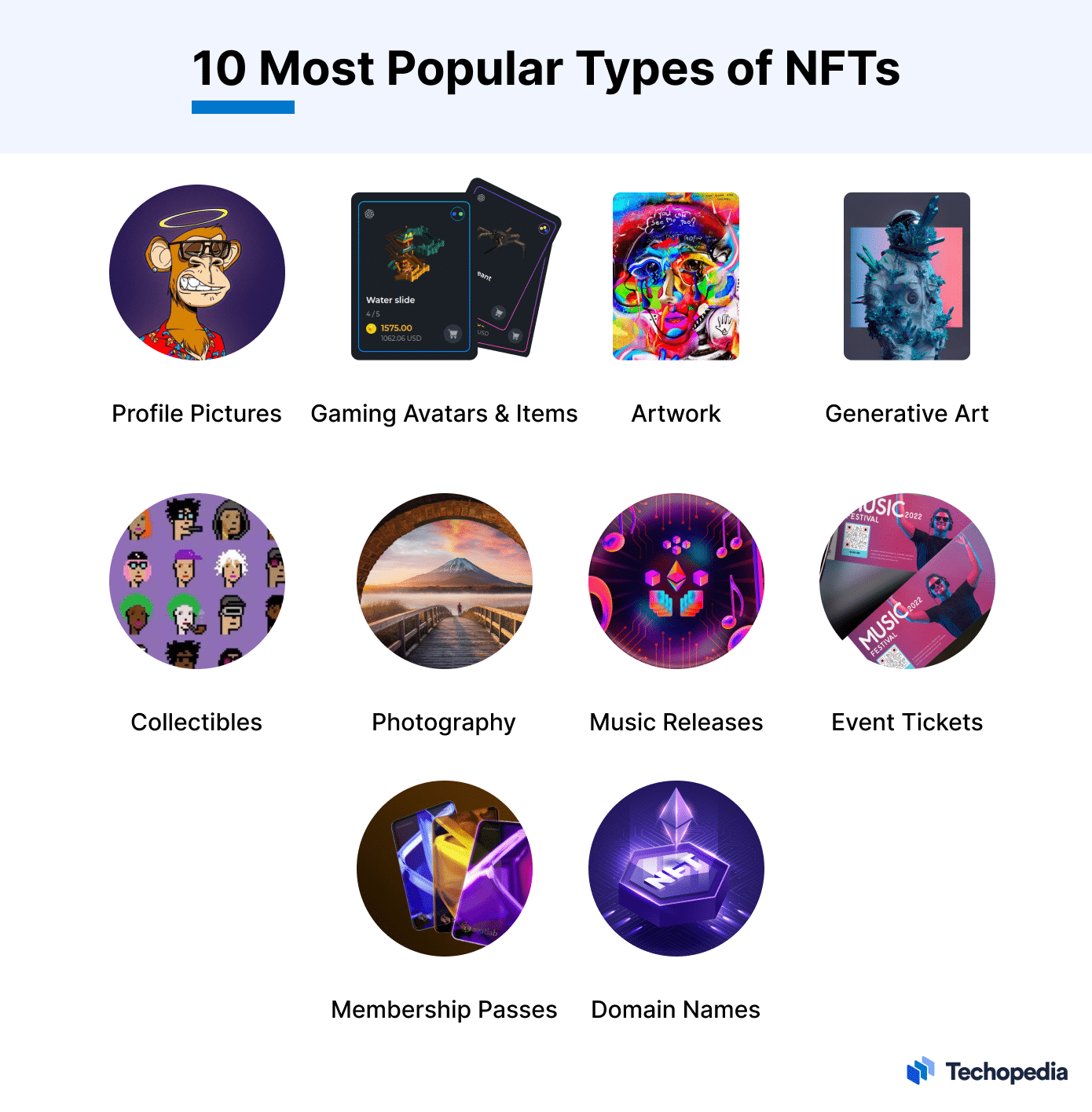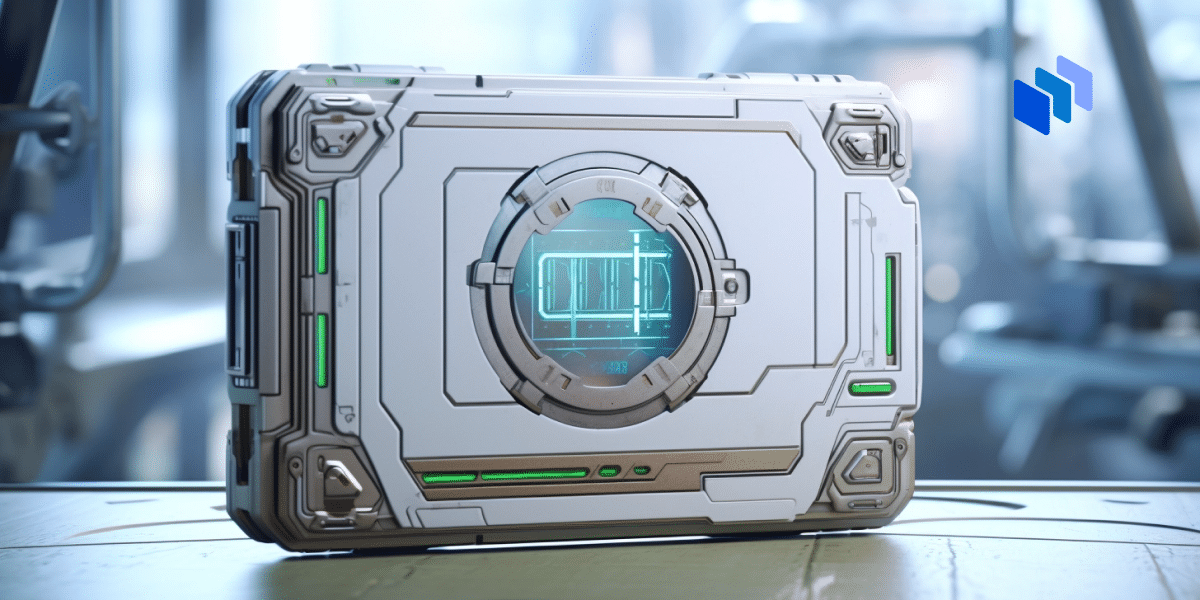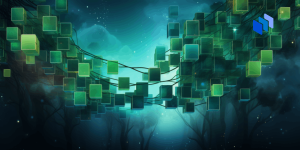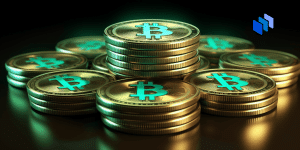The rise of non-fungible tokens (NFTs) has created new opportunities in the world of digital art and collectibles for creators to showcase and monetize their work.
NFTs offer a unique way for creators to establish ownership, authenticity, and rarity for their digital creations using blockchain technology.
By minting (creating) and selling their content as NFTs, creators can connect with their audience directly without intermediaries like galleries or agents. This enables them to retain more of their work’s income and take greater control.
Whether you’re an artist, musician, writer, or any other type of creator, it is essential to understand the process of creating an NFT to tap into the potential of this rapidly changing market.
NFTs became popular in 2021 when several prominent collections sold for millions of dollars. Sales volumes remained high into 2022, but interest waned as cryptocurrency prices turned bearish. However, innovations and applications for NFTs are emerging as momentum builds in Web3 development.
What is an NFT?
A non-fungible token is a unique digital asset representing a piece of art, music, collectible, or even a real-world asset. An NFT is created by a smart contract executed on a blockchain, and ownership is verified on-chain. NFTs are non-fungible because they cannot be exchanged for another asset with the same value.
NFTs are attractive as a store of value because there is only one version of each token and one owner at any time. Creators can set characteristics of an NFT, meaning they can define its rarity and determine its trading value.
Ownership of a unique, collectible item creates a sense of community among collectors and drives demand for rare tokens.
Preparing to Create an NFT
If you want to make your own NFT, you should take the time to understand the process before you get started.
Idea Generation and Conceptualization
Before diving into the technical aspects of creating an NFT, it is essential, to begin with a strong foundation: a unique idea. Brainstorming and conceptualizing your NFT will help you create work that stands out and resonates with potential buyers and collectors.
Your NFT should be original, offering something distinct and valuable, capturing the attention and interest of your target audience to tap into market demand.
To stimulate your creativity, explore various sources of inspiration. Engage in conversations with artists and creators in the NFT community to exchange ideas and gain fresh perspectives. Follow NFT marketplaces, social media accounts, and online communities focused on digital art and collectibles to stay updated on the latest trends and developments.
Explore NFT art platforms, galleries, and marketplaces to learn from the strategies of successful projects. Analyze what makes existing NFTs popular and use this insight to refine your approach. By immersing yourself in the NFT ecosystem, you can find inspiration and discover new possibilities for your NFT project.
Selecting an Artistic Medium
Explore the various artistic mediums suitable for NFT creation, such as digital art, music, and videos, to decide which aligns with your creative vision and technical skills.
Determine the form in which your art will be most impactful and authentic. Select a medium that allows you to express your ideas effectively. If you are comfortable working with digital tools and software, digital art may be a natural choice. Conversely, if you have a music production or video editing background, you could use those skills to create innovative NFT content.
Whichever medium you choose, it is vital to prioritize high-quality and resolution-independent work. NFTs are often viewed on various devices, from large screens to mobile phones. Ensuring your work retains its visual appeal and fidelity across different resolutions and screen sizes is crucial for maintaining its value and impact.
Spending time perfecting the composition, color, and overall presentation will help your NFTs stand out in a competitive market.
Understanding NFT Marketplaces
When it comes to selling and trading NFTs, understanding the different NFT marketplaces is essential to select the most suitable platform for your artwork and goals.
Popular NFT marketplaces include:
- OpenSea: One of the largest and most well-known NFT marketplaces, OpenSea offers a wide range of digital assets, including art, collectibles, virtual real estate, and more. OpenSea is known for its user-friendly interface, allowing creators to easily mint and list their NFTs. It also provides various customization options and supports multiple blockchains. However, the sheer number of listings on OpenSea makes it challenging for new artists to stand out.
- Rarible: A user-friendly platform for artists and collectors, Rarible features customizable NFT attributes, royalty settings, and a social feed for engaging with the community. It emphasizes the importance of community governance and involvement. However, creators face high gas fees as Rarible runs on the Ethereum blockchain. A lack of curation can make it difficult for high-quality projects to stand out.
- SuperRare: A curated marketplace focusing on high-quality, single-edition digital artworks, SuperRare offers a selective approach. The platform provides collectors with a visually appealing and immersive experience, emphasizing scarcity and uniqueness. The platform also incorporates an auction system for exclusive artworks. However, SuperRare’s exclusive curation creates a high barrier to entry for artists.
To choose the most suitable NFT marketplace for your artwork and goals, consider the artistic medium, as some marketplaces focus on specific mediums, such as digital art or music. Consider whether the platform caters to your target audience.
Explore the community and audience of each marketplace to see whether it attracts collectors and enthusiasts who appreciate and value your type of artwork. Evaluate each marketplace’s features and customization options and understand their fee structures and revenue-sharing models to ensure they meet your goals.
Look for platforms with a strong track record, positive user reviews, and a commitment to supporting artists and creators.
How to Create and Mint an NFT
There are several steps to creating and uploading content to generate – or mint – an NFT.
Preparing Content
Before you can mint your NFT, preparing the content to meet the technical requirements and optimizing its display on digital platforms is important.
Most NFT marketplaces accept common image formats such as JPEG, PNG, or GIF for static images and MP4, GIF, or WEBM for animations and videos. Make sure your work meets the required format for your chosen marketplace. Create high-resolution content in dimensions that can be displayed well on various devices.
Compress the file size without compromising quality, as large file sizes can result in slower loading times, affecting the user experience. Maintain the original aspect ratio of artwork to prevent distortion when it is displayed on different devices and platforms.
Consider watermarking your work to protect it from unauthorized use or plagiarism. Sign the work digitally or include your signature in the composition to establish authenticity.
Choosing a Blockchain Network
Selecting the appropriate blockchain network is a crucial step in minting your NFT. Popular blockchain networks used for NFTs include Ethereum, Solana, Binance Smart Chain, and Flow.
Each network has its own characteristics and ecosystem, so you will need to evaluate factors such as transaction fees, scalability, user base, and community support. How much does it cost to create an NFT? Transaction fees vary widely across different networks, so select one that aligns with your budget and goals.
Once you have chosen a blockchain network, create an NFT wallet. There are many NFT-compatible wallets based on your needs and preferences. For Ethereum-based NFTs, you can use wallets like MetaMask or Trust Wallet. Binance Wallet is the official wallet for BNB Chain NFTs.
Follow the wallet provider’s instructions to create an account and securely store your cryptographic keys.
Minting Your NFT
To mint an NFT, you create a unique digital asset on the selected marketplace. Here are the steps to follow:
- Connect your wallet: Once you have created an NFT wallet, connect it to your chosen NFT marketplace. On OpenSea and Rarible, click the Create button, choose your wallet from the list, and follow the prompts.
- Prepare metadata and information: You need to include metadata and other information for each NFT listing. This includes the title, description, tags, and any additional attributes or properties specific to the content.
- Specify royalties and pricing: Set the royalties you want to receive whenever your NFT is resold. Consider the marketplace’s royalty mechanisms and set a fair initial pricing for your NFT.
- Decide on the edition: Decide whether your NFT will be a unique piece or part of a limited-edition series. Specify the total number of editions.
- Mint: Follow the marketplace’s instructions to create and upload your NFT. This typically involves uploading the artwork, entering the required information and metadata, and confirming the transaction.
NFT Marketing and Promotion
Marketing and promoting your NFT is crucial to stand out in a competitive marketplace, generate buzz around your work, and attract potential buyers.
Crafting an Engaging Listing
Creating a listing that engages the viewer makes it more likely that they will buy or bid on your work. Create a title that grabs attention and accurately reflects your content. Use descriptive and intriguing language to pique curiosity and generate interest.
Craft a compelling description that tells the story behind your work. Share your inspiration, artistic process, and the aspects that make your NFT special. Share a bit about yourself as an artist. Highlight your background, accomplishments, and creative journey. Establishing a personal connection can build trust and interest among collectors.
Use high-resolution images with different angles, close-ups, and details to comprehensively showcase your artwork. Consider creating preview videos that bring your content to life. Show interactive elements, animations, or the process of creating your piece.
Collaborations and Partnerships
Collaborating with other artists and creators in the NFT space can offer numerous benefits and help expand your reach to a broader audience of collectors.
Participate in community discussions on social media to seek out artists and creators who share similar artistic values, themes, or styles. Explore the possibility of creating joint NFT projects or collaborations. This can involve co-creating new content, participating in themed collections, or supporting each other’s releases.
To effectively market your NFT, leveraging social media platforms and engaging with relevant communities is essential.
Establish a strong presence on platforms like Twitter, Instagram, and Discord. Share regular updates about your artwork and behind-the-scenes glimpses, and engage with your audience. Use relevant hashtags and tags to reach a wider audience and attract potential buyers.
Join NFT communities and forums where artists and collectors gather. Participate in discussions, share your artwork, and provide valuable insights. Engaging with the community can help you build connections, gain exposure, and receive feedback on your work. Consider organizing collaborative giveaways or participating in community events to increase visibility and foster engagement.
Popular Types of NFTs
- Profile pics (PFPs)
The most common types of NFTs are profile pictures, known as NFTs, which are issued in collections of hundreds or thousands in size. PFPs typically feature characters with different characteristics and rarity levels – such as clothing, accessories, and colors. Popular PFP NFT projects include Bored Apes, Cool Cats, CryptoPunks, Doodles, and Pudgy Penguins.
- Gaming avatars and items
The adoption of blockchains and NFTs has driven the emergence of play-to-earn (P2E) games, in which gamers use avatars to play and collect in-game items such as virtual land or weapons – all represented by NFTs. Players can use the NFTs to play and earn monetary rewards or trade them on marketplaces for profit. Popular games include Alien Worlds, Axie Infinity, Decentraland, and The Sandbox.
- Artwork
Digital artists can create NFTs to sell their work on online marketplaces. During uploading, they can specify characteristics and create unique (1/1) or multiple editions on the blockchain. Each piece has a different token ID to validate ownership.
Famous NFT artworks include Beeple’s “Everydays: The First 5000 Days,” which sold for $69.3 million in March 2021, and the Merge project by Pak, which brought in $91.8 million in December 2021.
- Generative art
Generative art refers to art that is randomly generated by a computer, such as an algorithm, artificial intelligence, or even a physical robot. The artist defines the parameters, number of iterations, and randomness, and the computer generates the artwork based on that framework. Popular generative art NFT projects include Autoglyphs by Larva Labs, Fidenza by Tyler Hobbs, and Lost Poets by Pak.
- Collectibles
NFTs bring the long history of sports trading cards and memorabilia into the digital world. NFTs offer a transparent and secure way to transfer ownership of unique assets, so they are well-suited to trading collectibles. Popular collections include NBA Top Shot, which allows basketball fans to own and trade officially licensed video clips, and Socios.com, where football fans can buy NFTs and cryptocurrency tokens from their favorite teams.
- Photography
Photographers can sell their digital or scanned photos on NFT marketplaces, giving them control over how they price their work. While the buyer has ownership of the NFT, the photographer retains copyright and reproduction rights. Each time an NFT photo is sold, the photographer receives royalties.
- Music releases
Music NFTs can link to individual songs, EPs, albums, or video clips. NFTs have the potential to change the way that musicians are paid for their work. Streaming services take the majority of the revenue generated from advertising and subscriptions. Still, NFTs enable artists to publish their music directly, receive most of the revenue, and earn royalties from secondary sales.
They have control over how many versions of their work they circulate, and they can release limited-edition audio files and music videos.
- Event tickets
Musicians, sports teams, and others can sell event tickets on blockchains as NFTs, enabling them to tally and reward attendees in new ways. NFT holders can use the tokens as access passes to live and virtual events, while issuers can send out notices, offer surprise giveaways, and provide exclusive access to sites and services.
In 2021, entertainment company Live Nation launched digital collectible NFT ticket stubs called Live Stubs, included with tickets for select shows. They allow fans to collect and trade ticket stubs in a digital format and artists to integrate special experiences and rewards.
- Membership passes
Like event tickets, NFT membership passes offer holders access to services and rewards from exclusive programs, including virtual and real-life experiences. Token-gating uses blockchain technology to verify NFT ownership and grant holders access to member perks.
- Domain names
Domain name platforms like Ethereum Name Service (ENS) and Unstoppable Domains allow users to buy and manage domain names for their digital assets, including websites and wallets as NFTs. These NFTs are tradeable on marketplaces like OpenSea, with popular domain names selling for millions of dollars.
Budweiser purchased the “beer.eth” domain name NFT for $95,000, while the “win.crypto” domain sold for $120,000 in March 2021.
5 Examples of Popular NFTs
- Beeple’s “Everydays: The First 5000 Days” Artwork
NFT artist Beeple has several prominent artworks, but Everydays marked an important milestone, as the first NFT digital artwork that was auctioned by a major auction house and sold for a record $69 million.
- CryptoKitties
CryptoKitties was launched in 2017, among the first successful NFT projects. The game on the Ethereum blockchain introduced collectible NFT digital cats with different attributes that users can breed and trade. The digital cats went viral and sold for up to $170,000 in equivalent ETH coins.
- CryptoPunks
CryptoPunks is one of the first PFP NFT collections and introduced generative art to the market. Artists Matt Hall and John Watkinson defined the attributes of CryptoPunks and used AI to generate 10,000 limited-edition avatars.
The collection is divided into series, with some rarer than others, such as Zombie and Alien CryptoPunks, are super rare. The most expensive CryptoPunks sold for 8,000ETH in February 2022, worth $23.7 million at that time.
- Bored Ape Yacht Club
Bored Ape Yacht Club (BAYC) is a collection of 10,000 unique PFP NFTs that are randomly generated from preset characteristics. The collection was developed by Yuga Labs, which subsequently offered Bored Ape NFT holders Bored Ape Kennel Club dog NFTs and released free “mutant serum” NFTs that Bored Ape holders could use to generate a rare Mutant Ape Yacht Club NFT.
BAYC NFTs also act as membership passes, as ownership gives holders access to club activities, merchandise, and in-person events.
In September 2021, auction house Sotheby’s sold a lot of 101 Bored Apes for close to $24.4 million.
- Grimes’ WarNymph
Musician Grimes sold a collection of 10 NFTs in February 2021 for $5.8 million. The collection titled “WarNymph” featured images and short videos set to original music and sold out within minutes. Some of the pieces were one of a kind, while others had thousands of copies.
Benefits and Challenges of Creating NFTs
As we have seen, NFTs create new opportunities for content creators, collectors, and investors. However, some issues can undermine the success of NFTs and limit adoption, which is essential to be aware of.
5 Advantages of NFTs
- Ownership: By leveraging blockchain technology, creators can establish verifiable ownership of their digital assets. Unlike traditional digital files that can be easily copied, NFTs provide a unique token representing the original piece, granting creators and collectors clear proof of ownership.
- Provenance: NFTs provide a transparent and immutable record of an asset’s history. Each transaction – including the initial creation, subsequent sales, and transfers – is recorded on the blockchain. This creates a permanent ownership trail, enhancing an NFT’s value and desirability.
- Authenticity: Counterfeiting and forgery are common problems in the art and collectibles markets. NFTs address this issue by enabling creators to authenticate their digital works. The blockchain ensures that each NFT is unique and cannot be duplicated or tampered with, guaranteeing the authenticity and integrity of the asset.
- Royalty mechanisms: One of the most significant advantages of NFTs is the ability to embed smart contracts that automatically trigger royalty payments to the creator each time the NFT is resold. This empowers creators to make money from NFT works from the appreciation in value and resale of their work.
- Transferability: NFTs facilitate seamless and secure transferability of digital assets. Unlike physical art or collectibles requiring complex logistics and intermediaries for sales and transfers, NFTs can be easily traded on marketplaces and transferred between wallets or platforms with minimal friction. This opens up global markets and helps creators to reach a broader audience, expanding their potential for exposure and sales.
5 Challenges of NFTs
- Environmental concerns: One of the significant criticisms surrounding blockchain technologies, including NFTs, is that the process of minting and trading NFTs often requires a substantial amount of energy due to the energy consumption associated with the blockchain’s consensus mechanism.
- Market volatility: NFT prices can fluctuate dramatically, influenced by various factors such as market trends, celebrity endorsements, and speculation. This volatility introduces risk for creators and investors, as NFT value can rise and fall rapidly, potentially leading to financial losses.
- Lack of regulation: While blockchain technology provides transparency and immutability, it lacks comprehensive regulations and standards, creating challenges regarding copyright infringement, intellectual property disputes, and ownership rights. This can make it difficult for creators to protect their rights effectively.
- Accessibility and inclusivity: While NFTs have opened up new avenues for creators, there are barriers to entry, including technical knowledge, platform fees, and transaction costs. These can limit the participation of emerging artists and creators with limited resources. And the concentration of attention on high-profile artists and celebrities can marginalize aspiring creators.
- Market saturation: The rapid growth of the NFT market has resulted in an influx of new entrants saturating the marketplace. It can be challenging for creators to stand out, and the sheer volume of projects can dilute the value of individual NFTs.
